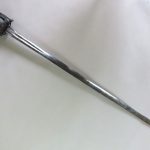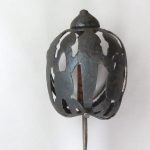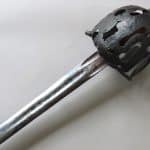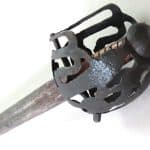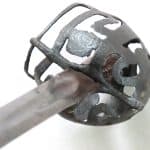
A Scottish Ribbon Hilted Broad Sword Dating to the Mid 17th Century
To enquire about this itemplease click here
Price: £4,300
Ref: 42502508
Item Description
A Scottish West Highland Ribbon Hilt, sometimes called “Beaked Neb”, Basket Hilted Sword, dating to the middle to late periods of the 17th century. These swords are often associated with Scottish Highlanders in the Civil War, Covenanting and early Jacobite Rebellion periods in Scotland.
The sword has a characteristic “Ribbon” hilt formed from wide flat iron bars forged together into the typical rounded profile. The front of the cross guard provides the focus for the convergence of the frontal guard bars into a pronounced beak which is a distinctive feature of this sword type and from whence it gets one of its titles.
The upper terminals of the guard arms are forged into a crescent of iron which fits into a groove cut for most of the way around the slightly flattened globular pommel just below its middle. The pommel has an integrally raised button on top.
The hilt retains its shape and although worn, russet and possessing a blackened aged patination, is whole, without breaks, repairs or losses. The sparse simple linear decoration usually found on ribbon hilts which delineates the panels, and adds interest to the bars, is visible in most parts. The hardwood grip is baluster shaped, of oblong cross section and spirally grooved now without any binding.
The high quality double-edged blade is of gently tapering form and of flattened lenticular section. The blade is thickened into a pronounced ricasso at the hilt which has a wide fuller alongside each blunt edge for the length of the ricasso (1.75 inches or 4.5 cm). The shoulders of the ricasso are accommodated and secured in a groove chiselled into the underside of the cross guard in the Scottish manner. A broad fuller runs from the end of the ricasso on each side for 7 inches (19 cm). Inside the fuller on one side is the feint mark in capital letters: “ANDREA FERARA” interspersed by dot patterns. The fuller on the other side shows evidence of the same device which is now illegible. Just beyond the end of the fuller on each side a clear running wolf bladesmiths’ mark is inscribed.
This style of blade seems to be a relatively common type encountered on ribbon hilts, which are recognised for the high quality of the blades they are mounted with. The steel blade is in fine condition having stood the tests of time more robustly than the iron bars of the hilt. This is not an unusual feature with ribbon hilts.
A contract dating to 1578 shows the bladesmiths Zanandrea and Zandona of Ferrara, working in Belunno, Italy, sixty miles north of Venice, secured a lucrative supply arrangement to manufacture thousands of blades for London based merchants John Brown and Lancelot Rowlandson, over a period of years before the turn of the 17th century. It seems the blades were of superior quality, hence the variations of the name stamped onto blades intended for import into Britain for over a century and a half to come by German blademakers as a spurious “copy-cat” mark of quality. This particular mark became especially popular with Scots and is often encountered on Scottish basket hilted swords of the 17th and 18th centuries. It may have had talismanic significance with some Highlanders even though most were illiterate. The blade was most likely made in Solingen.
The only so far known portrait depicting a Ribbon Hilt sword is that of Lord Mungo Murray by John Michael Wright, circa 1670, and he is shown in full Highland dress armed with a contemporary dag, dirk and long gun. His sword hilt is handsomely gilded.
For a further reference work on ribbon hilt evolution see “British Basket-Hilted Swords” by Cyril Mazansky (Boydell Press 2005) pages 69 to 73.
The overall length of the sword is 41.5 inches (105.5 cm) and the blade is 35.75 inches (91 cm).

